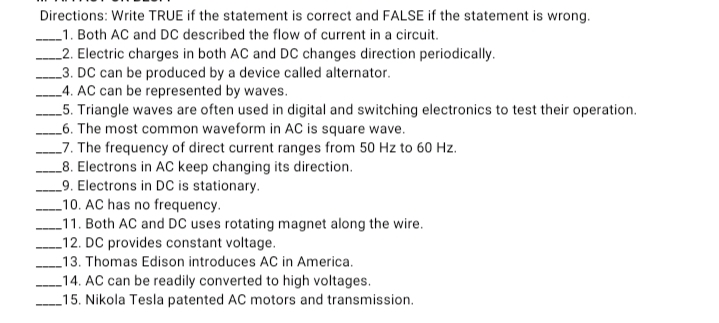_1. Both AC and Dc described the flow of current in a circuit. 2. Electric charges in both AC and DC changes direction periodically. _3. DC can be produced by a device called alternator. 4. AC can be represented by waves. _5. Triangle waves are often used in digital and switching electronics to test their operation. _6. The most common waveform in AC is square wave. _7. The frequency of direct current ranges from 50 Hz to 60 Hz. _8. Electrons in AC keep changing its direction. _9. Electrons in DC is stationary. _10. AC has no frequency. _11. Both AC and DC uses rotating magnet along the wire. _12. DC provides constant voltage. _13. Thomas Edison introduces AC in America. _14. AC can be readily converted to high voltages.
_1. Both AC and Dc described the flow of current in a circuit. 2. Electric charges in both AC and DC changes direction periodically. _3. DC can be produced by a device called alternator. 4. AC can be represented by waves. _5. Triangle waves are often used in digital and switching electronics to test their operation. _6. The most common waveform in AC is square wave. _7. The frequency of direct current ranges from 50 Hz to 60 Hz. _8. Electrons in AC keep changing its direction. _9. Electrons in DC is stationary. _10. AC has no frequency. _11. Both AC and DC uses rotating magnet along the wire. _12. DC provides constant voltage. _13. Thomas Edison introduces AC in America. _14. AC can be readily converted to high voltages.
Glencoe Physics: Principles and Problems, Student Edition
1st Edition
ISBN:9780078807213
Author:Paul W. Zitzewitz
Publisher:Paul W. Zitzewitz
Chapter25: Electromagnetic Induction
Section: Chapter Questions
Problem 74A
Related questions
Question

Transcribed Image Text:Directions: Write TRUE if the statement is correct and FALSE if the statement is wrong.
_1. Both AC and DC described the flow of current in a circuit.
_2. Electric charges in both AC and DC changes direction periodically.
_3. DC can be produced by a device called alternator.
_4. AC can be represented by waves.
_5. Triangle waves are often used in digital and switching electronics to test their operation.
_6. The most common waveform in AC is square wave.
_7. The frequency of direct current ranges from 50 Hz to 60 Hz.
_8. Electrons in AC keep changing its direction.
9. Electrons in DC is stationary.
_10. AC has no frequency.
_11. Both AC and DC uses rotating magnet along the wire.
_12. DC provides constant voltage.
_13. Thomas Edison introduces AC in America.
_14. AC can be readily converted to high voltages.
-15. Nikola Tesla patented AC motors and transmission.
Expert Solution
This question has been solved!
Explore an expertly crafted, step-by-step solution for a thorough understanding of key concepts.
This is a popular solution!
Trending now
This is a popular solution!
Step by step
Solved in 2 steps

Knowledge Booster
Learn more about
Need a deep-dive on the concept behind this application? Look no further. Learn more about this topic, physics and related others by exploring similar questions and additional content below.Recommended textbooks for you

Glencoe Physics: Principles and Problems, Student…
Physics
ISBN:
9780078807213
Author:
Paul W. Zitzewitz
Publisher:
Glencoe/McGraw-Hill

Glencoe Physics: Principles and Problems, Student…
Physics
ISBN:
9780078807213
Author:
Paul W. Zitzewitz
Publisher:
Glencoe/McGraw-Hill